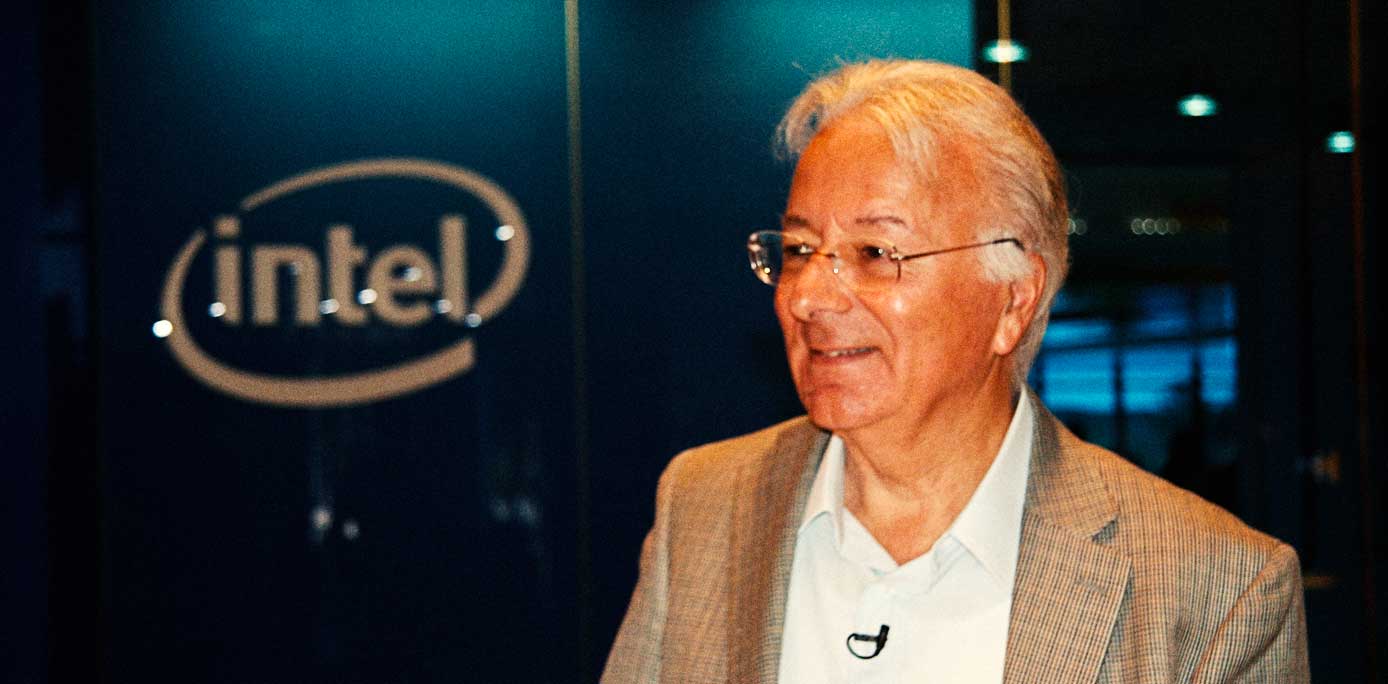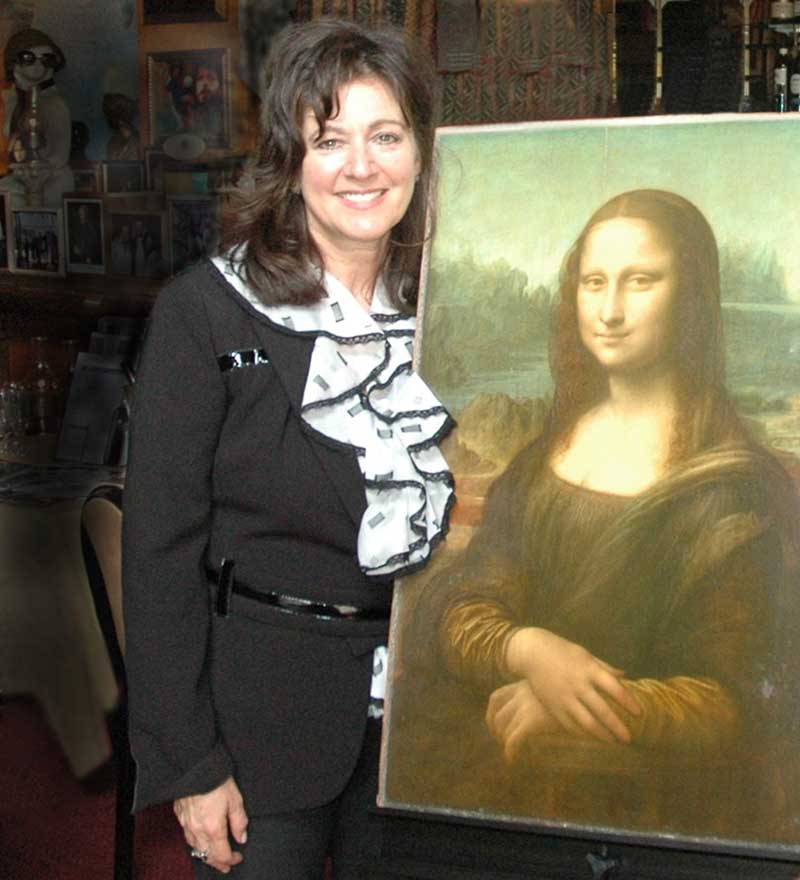Much has been written about Dr. Federico Faggin, Italian physicist, inventor, and entrepreneur, known for designing the first commercial microprocessor. But when L’Italo-Americano had the opportunity to interview him, the focus quickly became the man behind the genius.
In this interview, exclusively granted to L’Italo-Americano, we asked: who is Federico Faggin, the “regular guy?” What are his thoughts about his Italian heritage and culture? How did his Italianness influence his life’s work? In response to those questions, our conversation revealed glimpses of this creative and gifted individual.
Federico Faggin was born in Vicenza, Italy, in 1941. He describes growing up in an intellectual environment by saying, “My father was a teacher of history and philosophy at the liceo classico, a very traditional high school in Italy, but he was also a libero docente, which is like a Ph.D.
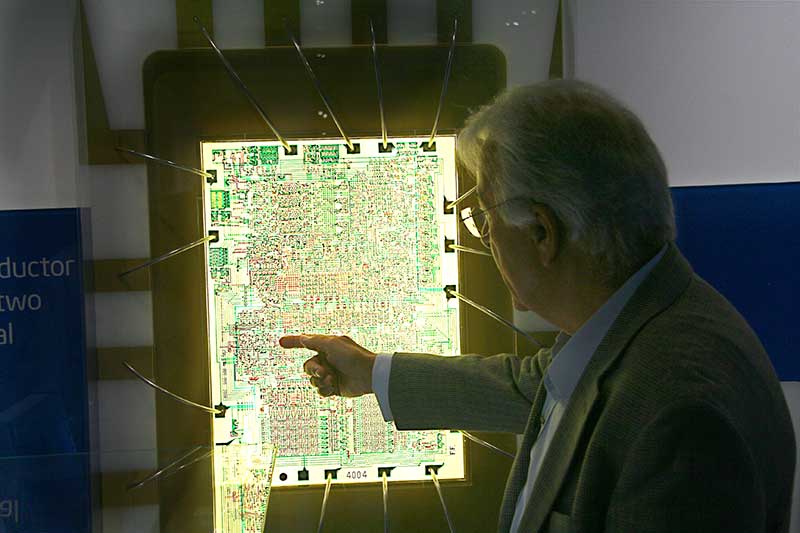
Federico Faggin points out the intricacies on an enlarged blueprint of the Intel 4004, which he designed and became the world’s first microprocessor in 1971. Photo: Intel Free Press/Flickr
He taught at the University of Padua and was a writer of about 40 books. My mother was an elementary school teacher.”
There were signs of Federico’s keen interest in technology beginning at an early age. This curiosity seemed to begin with building model planes. “Airplanes really fascinated me. By the time I was 11, I saw a model airplane fly and that changed my life. It was like I fell in love and I just had to build one myself.”
Faggin attended the Istituto Tecnico Industriale Statale (I.T.I.S.), a technical high school in Vicenza, with the intention of studying aeronautical engineering. As it happens, the school dropped that curriculum. It was then that he began his study of radio technology. And the rest, as they say, is history.
In the early 1960s, Faggin began working at the Olivetti Electronics Laboratory where he co-designed and built an experimental transistorized electronic computer. While studying physics at the University of Padua in 1965, he received his laurea in physics, graduating summa cum laude.

Federico Faggin, at the Computer History Museum’s 2009 Fellows Award event, where he was inducted a Fellow. Wikipedia
In 1967, he began work at SGS-Fairchild, now STMicroelectronics, in Italy. There he developed their first metal-oxide-semiconductor (MOS) technology, and their first two commercial MOS integrated circuits (ICs). In 1968, Faggin was sent to Silicon Valley in California to work at Fairchild Semiconductor where he was in charge of developing Fairchild’s self-aligned gate MOS process technology with silicon gates, the basis of all modern CMOS integrated circuits.
Joining Intel in 1970, Faggin led the design of the world’s first commercial microprocessor, the Intel 4004. This project also required the implementation of a new method for random logic chip design using silicon gate technology. Faggin, along with Masatoshi Shima, designed and developed all four ICs in Intel’s groundbreaking MCS-4 microprocessor family.
Faggin left Intel at the end of 1974 to found Zilog Inc., with Ralph Ungermann, and was the company’s president and CEO until 1980. Zilog was his first company, dedicated to the emergent microprocessor and microcontroller market. The Zilog Z80 microprocessor (1976), and the Z8 microcontroller (1978), are still in production. In 1982 he founded and directed Cygnet Technologies Inc., and in 1984 introduced a pioneering personal communication product for voice, data, and electronic mail.
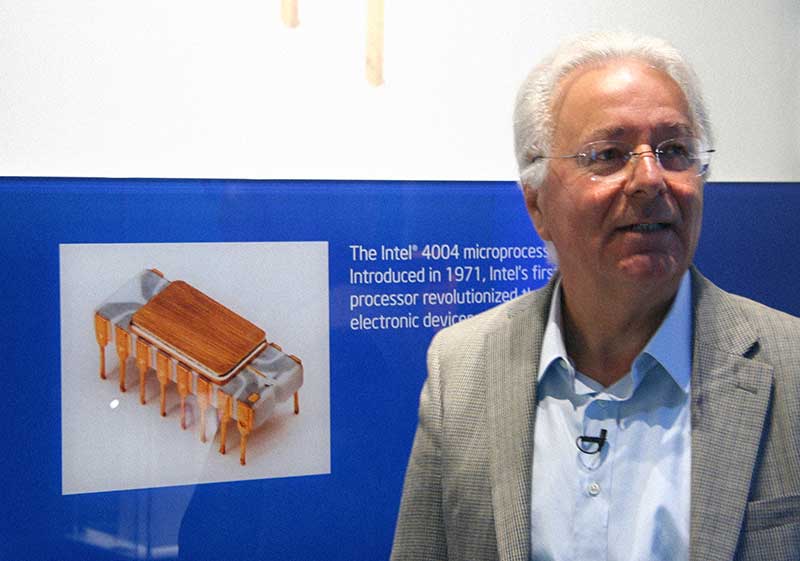
On a recent visit to Intel headquarters, Federico Faggin talked about his role designing the 4004 microcessor in 1971, which is considered the world’s first microprocessor, and he described its impact on society. Wikipedia
In 1986 Faggin co-founded and directed Synaptics Inc., the company that developed artificial neural network chips to perform pattern recognition. Today, Synaptics is the leader in human interface solutions, having pioneered the Touchpad (1994), and the Touchscreen (1999), that revolutionized the way we interface with mobile devices.
He later became president and CEO of Foveon Inc., a company making image sensors and digital cameras for mobile devices, from 2003 until the company was acquired in 2008.
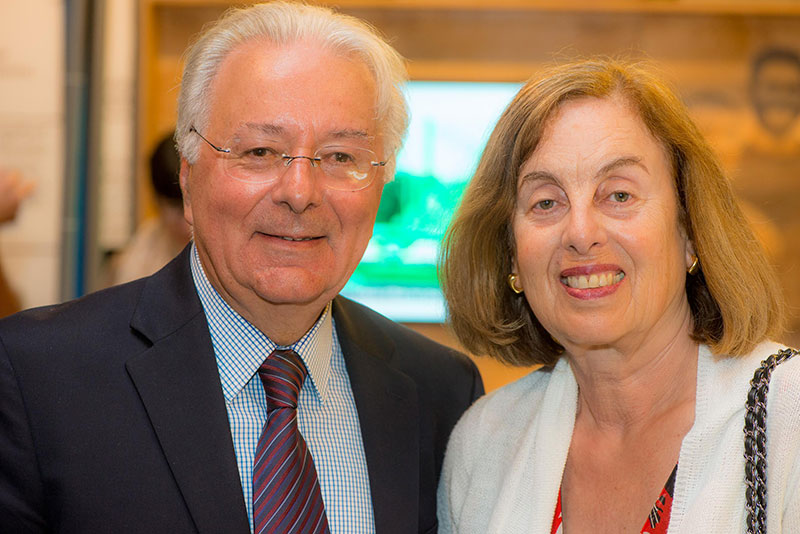
Federico and Elvia Faggin. © Federico Faggin
Faggin is currently president of the Federico and Elvia Faggin Foundation, a non-profit organization dedicated to the scientific study of consciousness, a long-standing interest that now has become a full-time activity. Founded in 2011, the Foundation supports various research programs at US universities and research institutes to advance the understanding of consciousness through theoretical and experimental research.
Undoubtedly, such a learned and accomplished person should be, and has been, the recipient of many prizes and awards. Among them are the Kyoto Prize (1997), shared with Hoff, Mazor, and Shima, and the 2009 National Medal of Technology and Innovation from President Barack Obama, with Hoff and Mazor. In addition, he has received the Marconi Prize (1988), and the Lifetime Achievement Award from the European Patent Organization (2006). In 1996, Faggin was inducted in the National Inventor’s Hall of Fame for the co-invention of the microprocessor and has received many honorary degrees in Computer Science and Electronic Engineering, including a Ph.D. in Electronic Engineering from the Polytechnic University of Armenia, and a Ph.D. in Science from Chapman University.
L’Italo-Americano asked Faggin if there was one prize in particular that touched his heart.
“Yes, there was an award called the Masi Prize. Masi is a winemaker in the Veneto region of Italy where I was born. They make Amarone wine, one of the top Italian wines in the world. Fondazione Masi set up a yearly prize that it gives to three people from the Veneto region who have distinguished themselves in the world. I received the Premio Masi in 1997.”
According to the Masi Foundation website, the awards began in 1981 with the Masi Civiltà Veneta Prize, given to individuals who originated from the Venetian territories and who had distinguished themselves in the fields of literature, art, journalism, science, the performing arts,and business. The actual prize itself is very special: a barrel of Masi Amarone, one of the most emblematic products of the Venetian lands. Of this honor, Faggin says: “The prize is a large cask of Amarone which is divided into thirds for the three people receiving the prize, so approximately 200 bottles of Amarone each. I received the prize for science and technology.
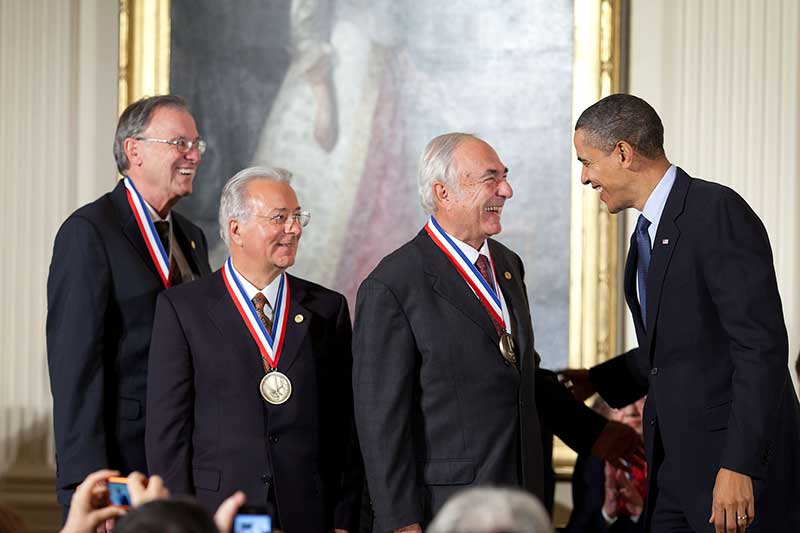
President Barack Obama talks with, from left, Marcian E. Hoff Jr., Federico Faggin, and Stanley Mazor, the creators of the world’s first microprocessor at Intel Corporation, during the National Medal of Technology and Innovation awards ceremony in the East Room of the White House, Nov. 17, 2010. (Official White House Photo by Pete Souza) November 17, 2010. (Official White House Photo by Pete Souza)
“The warmth behind the prize was the feeling of being appreciated by your people, by your kind from Veneto. The nature of the prize is such that it reflects the wine of your land and your earth and so the prize has so much affection. It is one of the prizes I remember with the most fondness, a prize from my land in Italy, from the people of my land.”
To further explore the man behind the genius, L’Italo-Americano posed the question: since much has been written about the technological aspects of your career, I would like to learn more about the person behind the genius. Is it possible to be a genius and a regular guy?
Laughing, Faggin replied, “The non-technology person is a regular fellow that likes to design, build, and fly model planes. My purpose was the enjoyment of flying – a way to fly without actually flying. It was a way to project myself into the plane and enjoy flight in an indirect way. I’ve loved planes since I was a kid.”
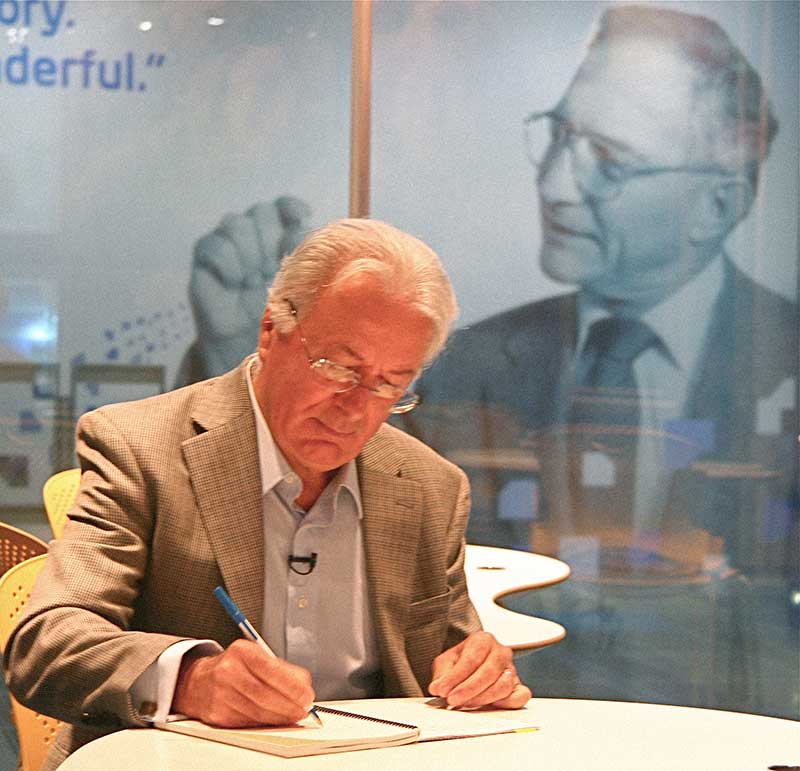
Federico Faggin designed the Intel 4004, which became the world’s first microprocessor in 1971, remembers working with Silicon Valley technology pioneers such as Intel’s first CEO Robert Noyce, pitched above and behind Faggin inside the Intel Museum. Wikipedia
How has your Italianness affected your life’s work? “I like to think the Italian culture affected me positively because there is a dimension of Italian culture that is more human and humanistic. There is more balance between a person’s personal life and professional life. They are not so separate. It gave me more passion and allowed me to place my emotional self into my work. It allows me to enjoy what I’m doing but also allows others around me to enjoy more of what they are doing.
“This ability is one of the reasons I wanted to be an entrepreneur and not just a technical person.
I wanted to be a person that could create companies. To do that there has to be a vision and the desire to create a team and a company culture. All those aspects of my personality were possibly richer due to my upbringing in Italy. People here in the US tend to be more rigid, more structured and less spontaneous and spontaneity is a very important quality.
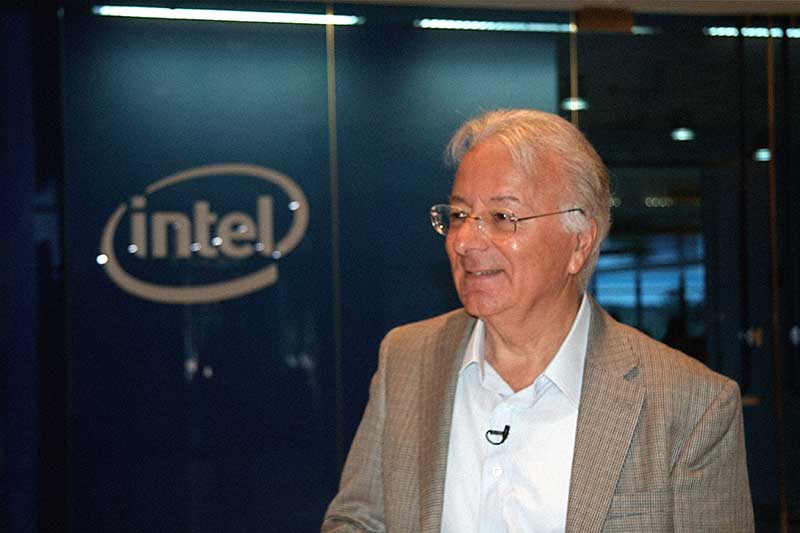
Federico Faggin, the designer of Intel 4004 which became the world’s first microprocessor in 1971 @wikipedia
“Also what my Italianness has done for me is to avoid becoming too specialized, allowing me to move from one area to another with the same level of enthusiasm and passion. These qualities have recently moved me to a different field: the study of consciousness. Until recently, consciousness has been considered a philosophical subject. However, I try to connect the science of the outer physical world with the not-yet-science of the inner world. This is a much deeper, much more important aspect in a world that thinks we humans are machines.
“The study of consciousness has occupied me full-time for the last ten years and part-time for the first 20 of the past 30 years. I would say it is perhaps connected to my Italianity, my cultural heritage. Italians tend to be fairly complete in the sense that they appreciate the inner aspects of reality and also the enjoyment aspects of life. For example, look at the way most people eat as opposed to the way Italians eat. Italians love to eat but they aren’t fat! Obesity to me points to something being out of psycho-physical balance. It shows that eating may have more to do with greed than with pleasure. Nothing is ever enough.”
When asked if his current work has taken him away from technology and toward human science, he replied: “There is a side of scientism that tends to see everything as a machine, something that is rational and logical. That kind of “You” denies reality to the inner life. It is alienating. That viewpoint is prevalent today and is disturbing particularly when considering artificial intelligence. We will be surpassed by machines, they tell us. That is very disturbing because it means people that feel this way have lost complete contact with their inner world, the world of emotions, creativity, and enjoyment. The way some scientists look at reality speaks to a meaningless universe, a universe that is a product of chance. This is such a dystopian view of reality and is a result of people disconnecting themselves from their inner lives.
“I’m not moving away necessarily from technology into only human nature, I’m simply reframing where technology has a place. Technology isn’t everything. There is a natural tendency to focus in such a way that you end up not seeing other aspects of reality. You think that everything is whatever you are focusing on at that moment. However, reality is much richer than our focus leads us to believe.”
Faggin went on to explain the work of the Federico and Elvia Faggin Foundation. “The work and focus of the foundation is to fundamentally raise the consciousness of the scientific community to the understanding that “consciousness” is most likely not produced by matter, as is commonly thought.
“In the materialistic worldview, consciousness is produced by the brain and when the brain ceases to function, consciousness is gone forever. Well, that is one way to look at the problem if one thinks that only matter exists. But no one has proven that.
“Science cannot explain the fact that we are conscious. Therefore, we must consider the possibility that consciousness may be an irreducible property of nature, in which case consciousness must be present in the elementary particles of which all matter is built. This idea is generally considered crazy. That’s why scientists give no reality to the inner world which is made of sensations, feelings, emotions, and thoughts, which are all about consciousness, and give only value to what is external.”
When asked how he proves his theory, the reply was enlightening. “You don’t need to prove it. You know it within yourself. The proof is the fact that we are conscious when we are supposed to be made of unconscious matter and therefore should be unconscious. What’s false to me is the idea that only inert matter exists.
“Because life has been studied as if it were a machine, we jump to the conclusion that machines can have consciousness. We are going down the wrong road as humanity. We are becoming automatons. Look at the kids with their iPhones. They seem connected with their tool and are forgetting to relate to other human beings for Christ’s sake! Is that the kind of future we want? A future where technological symbols replace empathy, compassion, and human relations?”
Would you create a computer that has consciousness and empathy? Would you go in that direction? His response: “No because it is not possible. But 30 years ago, I had bought into this line of thinking, I thought it should have been possible to make a conscious computer and I started thinking in that direction until I had some extraordinary experiences of consciousness that told me reality is much more than what we ordinarily think it is. The moment that you open your mind to more, life will give you those experiences and when you have them you can no longer go back.
“It’s like the fish that lives in the deep ocean and thinks that all that exists is just the water it experiences. When you take it out of the ocean and give it a peek of the waves, the sun, the clouds, and the islands in the distance, the fish will have a realization that reality is much more than just water.
“Can we somehow guide our conclusions into this kind of realization? Yes, we can. We can by wanting to know and by looking at the right places, through meditation, for example. Through questioning yourself little by little, you will put yourself in a position to experience beyond what we ordinarily experience. Expanding one’s consciousness is essential to being able to understand a broader reality.”
When asked if he would care to add to what we have discussed, he replied: “We’ve covered what I consider to be the ‘color of myself,’ the human color, the deeper, more intimate self, so we have gone beyond just the facts. The facts are nice but they are not enough.”
When asked if he had any plans for an autobiography, Faggin replied, “Yes, interesting that you would ask. I do have an autobiography written in Italian, and at a later time it will be released in English. I am almost certain that it will be available this year, 2019.”
And so it is with anticipation that we look forward to Federico Faggin’s autobiography and to learning more about the man behind the genius.
